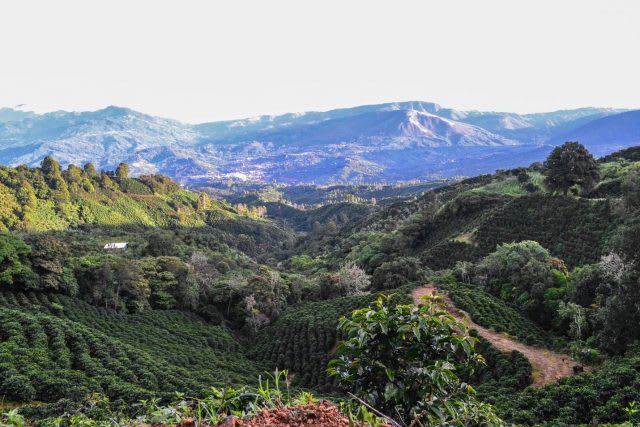Costa Rican Eco-Coffee-Dota Coffee The world's first carbon-neutral coffee

Professional coffee knowledge exchange more coffee bean information please follow the coffee workshop (Wechat official account cafe_style)
Although the development of global carbon-neutral agricultural products is slow, it has gradually taken shape. The most successful example is Costa Rica in Central America, where the Duota Coffee Cooperative became the first coffee producer in the world to obtain carbon-neutral certification.
■ Costa Rica coffee farmers brew up a carbon neutral future.
Fernando Solis Arguedas climbed to the steep roof of his house and looked closely at a leaf of the 50-year-old Arabica coffee tree. His family has a lot of coffee beans because it is the first carbon-neutral coffee in the world to be officially certified.
Solis sees signs of leaf rust in the early days, but he thinks it's because the climate is more unpredictable, and through sustainable agricultural techniques such as reducing chemical spraying and planting more shade trees, coffee produced by their Duota Coffee Cooperative (Coopedota) can be sold at a higher price than others.
Carbon neutralization and reduction of agricultural greenhouse gases
Although there has been an organic whirlwind around the world in recent years, carbon neutralization technology is the mainstream in Costa Rica, a Central American country with a population of 5 million that hopes to reduce greenhouse gas emissions from agriculture while meeting the demand for agricultural products with a growing population.
"this is not only a trend, but also means that we can sell our coffee to the international market, and if the market is $120, we may sell it for $180 or $200," says Solis, whose family has grown coffee for three generations. "although the cost is high, we think it is more beneficial to us."
Costa Rica already has three zero-emission coffee companies, as well as some carbon-neutral bananas, pineapples and cattle producers, making the country a pioneer of global carbon-neutral development.
Coffee is not the only drink for carbon-neutral products. Companies in Sri Lanka, India and Chinese mainland also produce zero-emission tea.
Coffee production has played an important role in the history of Costa Rica and is now famous for its high-quality Arabica coffee varieties. Although it currently accounts for only about 1% of the world's total coffee production, Colombia is still the 14th largest coffee producer in the world.
Costa Rica is also known for being environmentally friendly. As early as 2007, Costa Rica set an ambitious goal of achieving a carbon-neutral country by 2021, which means solving 37% of agricultural carbon emissions. Coffee accounts for nearly 10% of the country's total emissions.
Reducing environmental impact can also reduce costs
According to the United States Environmental Protection Agency, global agriculture, forestry and other land use account for about 24% of greenhouse gas emissions.
People in the coffee industry say Costa Rica's approach is to persuade coffee farmers to switch to fertilizers or mills to reduce energy and water consumption, or to turn coffee fruits into biogas, which can reduce costs in addition to reducing environmental impacts.
Many coffee farmers in the country have responded to future climate change in advance, and the Colombian government only recently lifted a 30-year ban on growing robusta coffee trees, which are more heat-resistant and germ-resistant than Arabica.
However, there is a certain cost to produce zero-emission coffee, and how to get more consumers to pay for it is still a major challenge.
Take the Duota Coffee Cooperative in Solis as an example. The company is located in the Saints' District, and almost all the villages and towns depend on coffee for a living. The factory of the Duota Coffee Cooperative is stocked with millions of coffee beans packed in sacks, and the air is filled with a strong smell of roasted coffee.
Although the Duota Coffee Cooperative is the first coffee company in the world to be certified for carbon neutrality, the 900-member cooperative's main goal was to reduce costs and improve efficiency. Only later did it gradually discover that there are additional environmental benefits in adopting the new process.
"after the introduction of carbon neutralization technology, water consumption has been reduced by 80% and energy consumption has been reduced by 40%," said Adrian Cordero, the company's environmental manager. "the company is currently using coffee shells instead of firewood as energy for coffee bean dryers."
Codelo said that half of the coffee produced by cooperatives is exported to the United States, while the rest is sold to new markets in Asia, where customers are willing to buy their products at higher prices.
Important Notice :
前街咖啡 FrontStreet Coffee has moved to new addredd:
FrontStreet Coffee Address: 315,Donghua East Road,GuangZhou
Tel:020 38364473
- Prev

What are the local conditions? What is the effect of local conditions on the flavor of coffee?
Professional coffee knowledge exchange more coffee bean information please follow the coffee workshop (Wechat official account cafe_style) What Is Terroir and How Does It Affect Your Coffee We often hear the word "local conditions" when talking about coffee, but what exactly does "local" mean? Does it have anything to do with the flavor of coffee? Why do we need to care about the local environment? Author mining
- Next

SCAA Chinese official website SCAA about fine coffee standard scaa barista certification how to test
Professional coffee knowledge exchange more coffee bean information please follow the coffee workshop (Wechat official account cafe_style) SCAA, the full name-Specialty Coffee Association ofAmerica, the Chinese translation of the American Special Coffee Association and a small number of people known as the American Fine Coffee Association. SCAA is committed to pursuing the excellent quality and excellence of coffee from seed to cup.
Related
- Detailed explanation of Jadeite planting Land in Panamanian Jadeite Manor introduction to the grading system of Jadeite competitive bidding, Red bid, Green bid and Rose Summer
- Story of Coffee planting in Brenka region of Costa Rica Stonehenge Manor anaerobic heavy honey treatment of flavor mouth
- What's on the barrel of Blue Mountain Coffee beans?
- Can American coffee also pull flowers? How to use hot American style to pull out a good-looking pattern?
- Can you make a cold extract with coffee beans? What is the right proportion for cold-extracted coffee formula?
- Indonesian PWN Gold Mandrine Coffee Origin Features Flavor How to Chong? Mandolin coffee is American.
- A brief introduction to the flavor characteristics of Brazilian yellow bourbon coffee beans
- What is the effect of different water quality on the flavor of cold-extracted coffee? What kind of water is best for brewing coffee?
- Why do you think of Rose Summer whenever you mention Panamanian coffee?
- Introduction to the characteristics of authentic blue mountain coffee bean producing areas? What is the CIB Coffee Authority in Jamaica?

